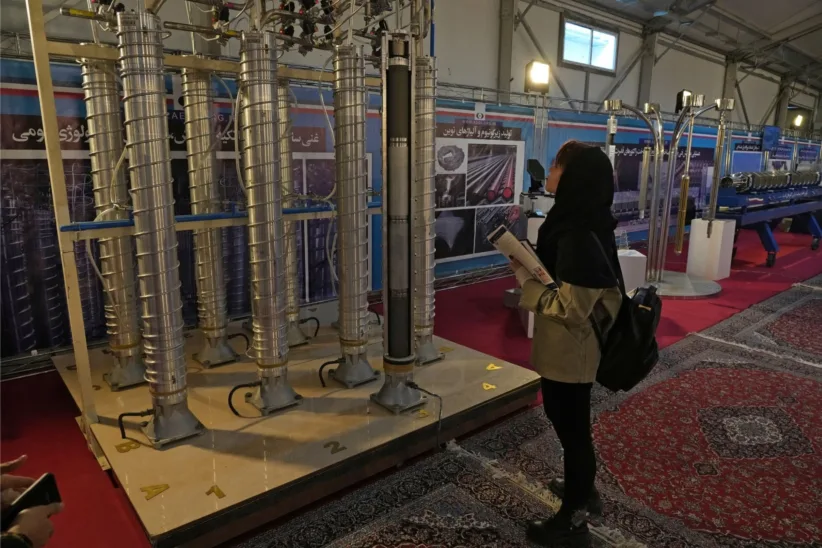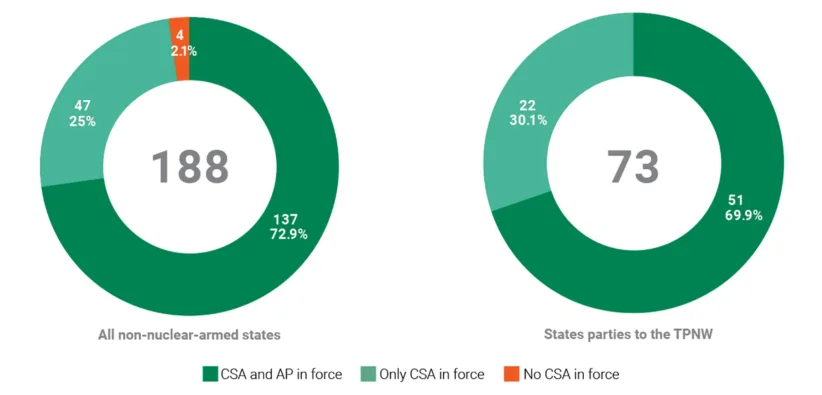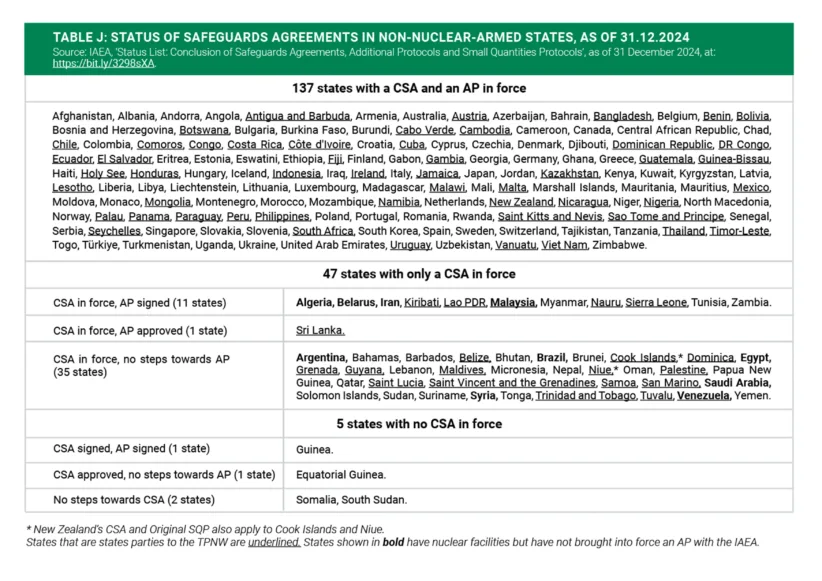The obligation to have Safeguards Agreements and Additional Protocols with the IAEA
In 2024, Timor-Leste brought into force both a Comprehensive Safeguards Agreement (CSA) and an Additional Protocol (AP) with the International Atomic Energy Agency (IAEA) on the same day. At the close of 2024, 137 states—73% of the global total of 188 non-nuclear-armed states—had brought into force both a CSA and an AP, thus committing to the current ‘gold standard’ of safeguards. The number of states that had a CSA in force but not yet an AP, remained at 47 (25% of the total). Finally, the number of states that do not yet have a CSA in force (and therefore also not an AP) had been reduced to just four: Equatorial Guinea, Guinea, Somalia, and South Sudan.

The Figure and Table below summarise the status at the end of 2024 of safeguards agreements among non-nuclear-armed states as a whole and among states parties to the Treaty on the Prohibition of Nuclear Weapons (TPNW). To support further progress in universalisation of CSAs and APs, the Nuclear Weapons Ban Monitor’s state profiles on this website contain information on all states’ respective safeguards agreements or lack thereof, as well as recommended actions. States that have not brought into force both a CSA and an AP should do so as a matter of urgency. Furthermore, states that maintain an operative original Small Quantities Protocol (SQP) should upgrade to a modified SQP, or in those cases that no longer meet the criteria for scaled down safeguards, rescind it.
For more information, see the 2024 edition of the Nuclear Weapons Ban Monitor.
Status of safeguards agreements in non-nuclear-armed states, as of 31.12.2024


ARTICLES 3(1), 3(2), 4(1), AND 4(3) - INTERPRETATION
- It is mandatory for all non-nuclear-armed states parties to the TPNW to maintain in force or to conclude and bring into force (and thereafter maintain) a Comprehensive Safeguards Agreement (CSA) with the IAEA. The TPNW specifies that the CSA must be based on the most recent CSA model in IAEA doc. INFCIRC 153 (Corrected). If a non-nuclear-armed state has not brought into force a CSA upon adhering to the TPNW, Article 3(2) stipulates that it must do so within a deadline of 18 months from the date of entry into force of the TPNW for the state in question.
- An Additional Protocol (AP) with the IAEA, or an instrument of equivalent or higher standard, is also mandatory for all non- nuclear-armed states parties that had one in force upon the entry into force of the TPNW on 22 January 2021.
- These are only minimum requirements, and the TPNW implicitly encourages states parties to adhere to the highest standard of safeguards. At present, this is the above-mentioned CSA and an AP.
- If a nuclear-armed state eliminates its nuclear-weapons programme and then adheres to the TPNW it will be obliged to conclude a safeguards agreement that provides ‘credible assurance of the non-diversion of declared nuclear material from peaceful nuclear activities and of the absence of undeclared nuclear material or activities in that State Party as a whole’. (Article 4(1)). This formulation equates to, at least, a CSA and a full AP. This means that the state in question will have to upgrade its existing safeguards agreement to a CSA and the requisite AP. Negotiations on these safeguards must start within 180 days, with the resultant treaty entering into force within 18 months of the TPNW’s entry into force for the state in question. These states must maintain, as a minimum, these safeguards, but may adopt more far-reaching safeguards in the future.
- If a nuclear-armed state adheres to the TPNW before eliminating its nuclear-weapons programme it will also be obliged to conclude a safeguards agreement that provides ‘credible assurance of the non-diversion of declared nuclear material from peaceful nuclear activities and of the absence of undeclared nuclear material or activities in the State as a whole’. (Article 4(3)). Again, this formulation equates to, at least, a CSA and an AP. Negotiations on these safeguards are mandated to start no later than the completion of nuclear elimination, with the resultant treaty entering into force within 18 months. These states must maintain, as a minimum, these safeguards but may adopt further safeguards in the future. The Treaty does not specify safeguards that should be applied between entry into force and the completion of nuclear elimination for these states, but these may be agreed in the legally-binding, time-bound plan for the verified and irreversible elimination of these states’ nuclear-weapons programmes that is required, and which includes the elimination or irreversible conversion of all nuclear-weapons-related facilities.
What are safeguards agreements?
- The NPT, nuclear-weapon-free zone (NWFZ) treaties, and the TPNW oblige non-nuclear-armed states parties to conclude safeguards agreements with the International Atomic Energy Agency (IAEA). Safeguards agreements are important both to prevent further states from developing nuclear weapons and to maintain a nuclear-weapon-free world once nuclear disarmament has been achieved.
- Under these agreements, the IAEA applies safeguards to nuclear facilities and material in order to verify that those facilities are not misused, and that nuclear material is not diverted from peaceful purposes to the development of nuclear weapons or other nuclear explosive devices. The IAEA analyses state declarations, data derived from IAEA safeguards activities in-country (such as visits and inspections) and at IAEA headquarters, and other sources of information in order to reach a safeguards conclusion. If positive, this is intended to provide credible assurance to the international community that states are abiding by their safeguards obligations.
- There are three types of safeguards agreements: Comprehensive Safeguards Agreements (CSA) with NPT non-nuclear- weapon states; voluntary offer safeguards agreements with NPT nuclear-weapon states; and item-specific safeguards agreements with states not party to the NPT.
- The CSA provides for safeguards on all nuclear material in all peaceful activities in non-nuclear-armed states, to verify that it is not diverted to nuclear weapons or other nuclear explosive devices. The objective is to ensure the timely detection of diversion of significant quantities of nuclear material from peaceful nuclear activities to the manufacture of nuclear weapons or of other nuclear explosive devices or for purposes unknown, and deterrence of such diversion by the risk of early detection.
- The IAEA Board of Governors approved a Model Additional Protocol (AP) to safeguards agreements in 1997, which expands the Agency’s access to information and sites, including to undeclared locations, and authority to investigate inconsistencies in states’ declarations. According to the IAEA, it is only in countries with both a CSA and an AP in force that the Agency has sufficient information and access to provide credible assurances of both the non-diversion of nuclear material and the absence of undeclared nuclear material and activities.
- Non-nuclear-armed states with minimal quantities of nuclear material and no nuclear material in a facility may conclude a Small Quantities Protocol (SQP) to their CSA, which suspends certain CSA safeguards under specific conditions, to reduce their safeguards burden while still enabling effective verification of their non-proliferation obligations. The IAEA Board of Governors approved a Modified SQP in 2005 to reduce the number of suspended provisions of the CSA, and strengthen declaration and inspection procedures. Many states are yet to upgrade their SQP to this new standard, and some of these are yet to conclude an AP, meaning that the IAEA’s capability to conduct activities to detect any undeclared material and facilities is reduced.
For more information, see: IAEA, ‘Safeguards explained’, and ‘Safeguards Basics’.